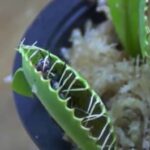As an Amazon Associate, this site earns commissions from qualifying purchases. For more details, click here.
Pitcher plants are beautiful to look at and it is understandable if you get the urge to touch its leaves and pitchers. But is it a good idea to do so? Is there any risk when you touch a nepenthes or sarracenia? There are some misconceptions about this due to the plants being carnivorous, so let us clear things up here.
Touching pitcher plants will not cause any harm, and you can even drink the liquid of an unopened pitcher. While touching it is safe for humans, the plant could suffer from stress so it should be avoided.
What Happens If You Touch Pitcher Plants?
Because pitcher plants are carnivorous, the question of safety often comes up. These plants eat meat, so how safe are they for humans? If you keep these plants at home, are you putting yourself in danger? What if you accidentally touch its trap put your finger in there?
Nothing bad will happen if you touch a pitcher plant. You can hold the leaves, flowers or liquids and you will be fine. Pitcher plants are not capable of harming people or pets.
You can feed nepenthes or sarracenia plants without worry. Touching the plant or the liquid in its pitcher is not going to harm you. The liquids in an unopened pitcher is safe to drink, while those in an open pitcher are filled with viscous fluids used to trap prey.
But even open pitchers are safe to touch. It feels sticky to the touch but will not irritate your skin. While these plants are carnivorous, their digestive system can only handle small insects and bugs.
The idea that pitcher plants can harm people is due to the way they are portrayed in sci-fi and horror films. In fact these plants are at greater risk from humans and pets than the other way around.
The leaves, liquids and nectar pitcher plants produce are for small bugs only. A rat or large frog will have no problems getting out of the pitcher. A large earthworm can chew its way out of the trap, eat the leaves and drink the liquids without hurting itself.
Why Pitcher Plants are Safe to Touch
Understanding how pitcher plants behave will show why they are safe to touch. It comes down to their feeding mechanism and why they eat bugs.
Pitcher plants only eat insects and small bugs. Ants, gnats, flies, butterflies, crickets and other insects make up their diet. They can also eat fish food, freeze dried mealworms and bloodworms. But they cannot consume large animals, let alone humans.
Nepenthes and sarracenia grown outdoors eat bugs and do not require additional feeding. But if yours is indoors, you can augment their diet with Kaytee Mealworms which are as nutritious as bugs.
Pitcher plants are too small to harm people. You can put your finger in a pitcher and nothing will happen. It is not going to squeeze around your finger or anything like that. The reason is pitcher plants only eat bugs small enough to digest and contains the nutrients they need.
Nepenthes and sarracenia pitcher plants produce nectar to lure potential prey. The nectar is all over the pitcher. The slippery leaves causes any bug that lands on them to fall into the trap.
Once the prey falls into the trap, the liquids prevent it from getting out again. Additional fluids are released that dissolve the insect. It is digested and converted into nutrients.
The digestive juices of a pitcher plant cannot harm people. You can get that stuff on your hand and it will not hurt. Pitcher plants do not bite or eat their prey the way animals do. They use digestive juices to dissolve the tissues, but it only works on small animals.
Pitcher plants eat very few insects. A typical nepenthes only needs one bug a week. You can feed it more often, but once a week is the maximum. You can leave a bunch of insects in its pitchers, but once the plant has had its nutritional needs met, it will not eat any more. A small insect is enough and they are incapable of eating large amounts of meat.
Does Touching Pitcher Plants Harm the Plant?
Placing your finger in a pitcher plant is harmless. However, repeatedly touching its leaves can damage the plant. Despite being carnivorous, pitcher plants are quite sensitive to sudden changes in their environment.
Nepenthes and sarracenia pitcher plants react to any sudden changes in the light, water, soil, humidity, temperature etc. around them. This is why when you bring home a new pitcher plant, it is normal to see some leaves turn black because it is adjusting to its new environment.
Now imagine if you were to touch its leaves. These plants are sensitive to any anything that lands on its leaves. If you touch it, the plant will have a hard time figuring out what it is. If you place your finger in the pitcher it will probably try to release digestive fluids.
These digestive juices will not do anything to you, but it will require a lot of energy from the plant. The plant can secrete all its digestive juices and it will not be enough to harm your finger.
In some cases just touching the pitcher can harm the plant. Its surface is coated with the moisture of nectar which it uses to attract prey. If you put your hand on the pitcher, the nectar would get on your hands. Again this will not harm you, but you will be depriving the plant. Without nectar, pitcher plants cannot trap insects.
In spite of their reputation, pitcher plants are vulnerable to any sudden change in their surroundings. Most nepenthes prefer 65-85 degree temperatures for instance, and if it climbs up to 90 or 100 F, its leaves could dry out.
These plants also get affected by changes in humidity and the amount of food they receive. The more food pitcher plants eat, the faster they grow. Now if you keep touching its leaves, the plant will react to this and expend a lot of energy.
Tips For Growing Pitcher Plants
So far we have established that touching pitcher plants is safe. In fact that will probably harm the plant more. However thee are other things that you can do to help them grow and live longer.
Light
Nepenthes and sarracenia benefit from at least 6-8 hours of light every day. Natural sunlight is the best, partial, direct or both. Sarracenia can handle direct light better than nepenthes as long as the temperature is at 90 F or lower.
You can use grow light fixtures as well. These will work well with indoor pitcher plants or those in a terrarium for instance. During the growing period, you have to provide as much light as possible. Our pick is the Aceple LED Grow Light because it is safe for any plant.
Temperature and Humidity
Pitcher plants prefer humid environments with plenty of light. Try to keep the humidity at 40% or higher and the temperature at 65-85 F (22-32 C). You have to increase the humidity as the temperature rises. During cool weather you can lower the humidity level. You can use a humidifier in this cases.
If your pitcher plant is in a terrarium, make sure it gets enough ventilation and does not overheat. Allow fresh air to come in every now and then and feed it regularly. In fact some carnivorous,plants do not grow well in terrariums so check the species first.
Soil, Water and Pot
Pitcher plants only grow in poor soil. Use peat moss and perlite with a ratio of 1:1. The pot should be at least 5 inches deep.
The soil must never go dry. Water enough to keep the soil moist without being too damp. If your pitcher plant goes dormant, the soil only needs to be slightly wet. You should still water it but reduce the amount.
Touching pitcher plants will not hurt you in any way. As pointed out here there is a greater risk to the plant than you. So it is a good idea to avoid touching your pitcher plants to ensure its safety. And try to keep pets away from the plant as well.

My fascination with carnivorous plants began many, many years ago with Venus Fly Traps. Now I am more than happy to impart what I know with other enthusiasts and those who are curious about meat eating plants.



